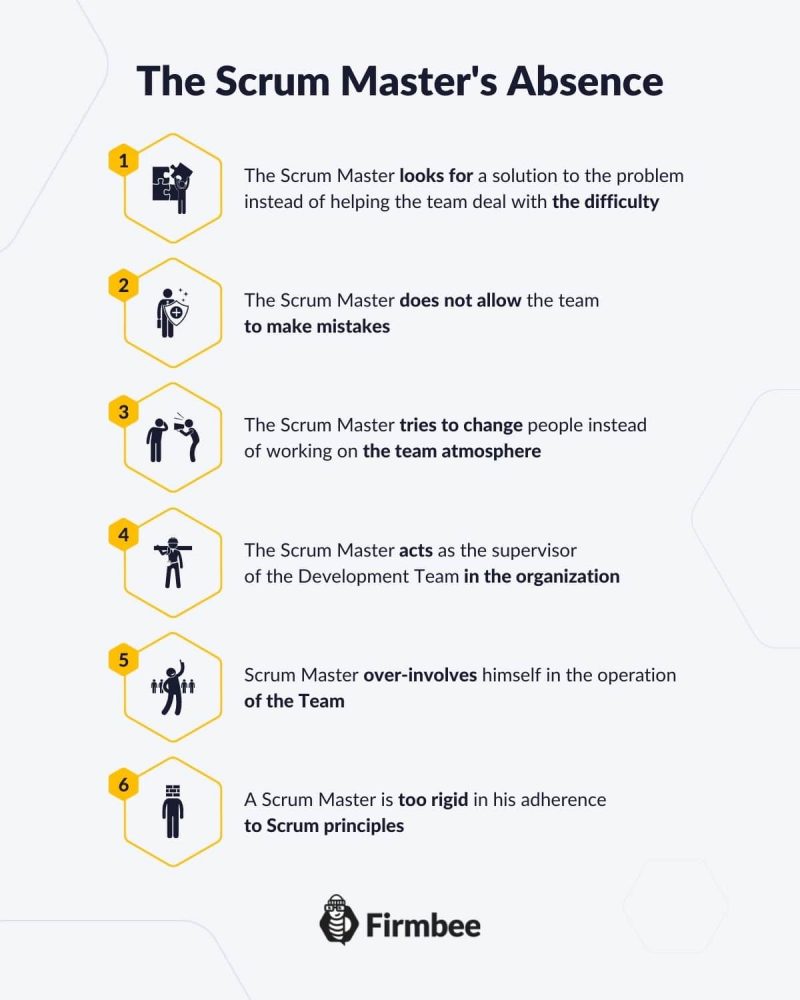The work of a good Scrum Master can be recognized by the fact that at some point they are no longer needed in the daily work of the Development Team. However, this is not always the case. What are the reasons for the mistakes of Scrum Master?
Mistakes of Scrum Master – table of contents:
A Scrum Master’s job is primarily to support the work of the Development Team. Therefore, the most common mistakes of Scrum Master usually stem from the way he participates in the daily functioning of the Developers. We’ve divided these mistakes of Scrum Master into two groups. The first one includes problems resulting from too much involvement, while the second one includes problems resulting from the insufficient presence of the Scrum Master in the life of the Development Team.

Too much control
The need to maintain too much control over the Team often causes mistakes in the application of Scrum. Scrum Master errors most frequently become apparent in the following situations.
- The Scrum Master looks for a solution to the problem instead of helping the team deal with the difficulty. Typically the root of the problem is that the Scrum Master is also an expert in what the Development Team is doing. Their inability to step out of the expert role makes them unable to effectively assist the team in finding solutions on their own. This approach can also lead to one-person, authoritarian decision-making – and this is probably the biggest mistake a Scrum Master can make.
- The Scrum Master does not allow the team to make mistakes. This problem is closely related to the previous one. If the team is effectively protected by the Scrum Master from making mistakes, it will not learn to solve problems on its own or take responsibility for its work. It will always rely on the advice and expertise of the Scrum Master.
- The Scrum Master tries to change people instead of working on the team atmosphere. This problem includes too much emphasis on changing the behavior of a team member or members, as well as personnel changes. It is a mistake to change the composition of the Development Team while working on a Product Goal if it is not absolutely necessary. It can introduce significant delays in its realization, and disturb the rhythm of work of the Development Team. And also disrupt the rhythm of the Team formation, about which we write in a separate article.
- The Scrum Master acts as the supervisor of the Development Team in the organization. This is a mistake that does not often result from the Scrum Master’s own decisions. However, it can exacerbate all the errors that arise from the need to control the Team.
- Scrum Master over-involves himself in the operation of the Team. When the Team is composed of experts who know each other’s skills and responsibilities and is functioning according to Scrum principles, the Scrum Masters should not interfere uninvited with the way the Team works. If they do, they are simply interfering with the smooth running of the team. Good Scrum Masters, thanks to their well-established position as a coach and leaders, will be asked for advice in emergency situations or situations requiring a fresh look. That’s why they should be available on call for Developers without not imposing their presence.
- A Scrum Master is too rigid in his adherence to Scrum principles. If any aspect of Scrum is not working in a particular Team, the Scrum Master should try a different approach. Every Team is different, and Scrum is just a general framework.

Too little commitment
Not only too much but also not enough Scrum Master’s involvement can lead to many mistakes. We have described the most common ones below.
- The Scrum Master is insufficiently familiar with Scrum principles. This mistake will most likely lead to their improper implementation. And the Team’s work will only seemingly be Scrum work.
- The Scrum Master is not enforcing the Scrum principles. The Scrum Master’s inadequate day-to-day presence means that he is not protecting the team as he should. This can lead to a lack of protection from the influx of outside tasks. Or to the failure of the Development Team to meet the Sprint Goal.
- The Scrum Master does not make sure that a consistent Scrum rhythm is followed. Carelessness in organizing Scrum Events can lead to wasting time. This will result in too long or poorly run Events – Sprint Planning, Sprint Retrospective or Sprint Review (which we’ll write about in separate posts). It is also a mistake to postpone events or change their duration.
- Scrum Master does not respond to conflicts in the Team. Expecting conflicts on the Team to resolve themselves over time is a Scrum Master’s mistake. Conflict is not always bad, but the Scrum Master should not only be aware of its existence and current state but also engage in it as a negotiator. And also be able to use the conflict to change and improve the Team.
- Insufficient Scrum Master presence. The problem arises when the Scrum Master spends too little time working with the Team and gets involved in specialized tasks, for example. This makes him listen too little and ask too few questions. This, as we wrote in the previous article, is a key skill for a Scrum Master. The result is that the Scrum Master doesn’t know well enough what is the current situation and atmosphere in the Team. And he is content with the status quo.
- The Scrum Master does not question the status quo. In order for the Development Team, and the Scrum Team as a whole, to grow, it is necessary to constantly challenge the status quo. This is often a risky and potentially inflictive activity. A Scrum Master should undertake it with the awareness of the difficulties he may encounter. However, there is no such thing as a ” mature Development Team that is no longer evolving”. Leaving it alone will quickly lead to a significant deterioration in its performance.
- The Scrum Master does not share his observations of the Team’s performance with the Team. Keeping this knowledge to themselves makes it difficult, or even impossible, for the Team to grow. While completely focused on daily responsibilities, Scrum Master does not work on the way the team members work together. This frequently leads to the accumulation of problems and conflicts.

Common mistakes of Scrum Master – summary
Mistakes of Scrum Masterresulting from insufficient or excessive involvement with the Development Team can destroy the rhythm of the work. And even contribute to stopping the activity according to Scrum rules. Therefore it is worthwhile for a Scrum Master to be aware of the potential errors and the resulting risks. And also to keep an eye on their relationship with the Team.
If you like our content, join our busy bees community on Facebook, Twitter, LinkedIn, Instagram, YouTube.
Author: Caroline Becker
As a Project Manager, Caroline is an expert in finding new methods to design the best workflows and optimize processes. Her organizational skills and ability to work under time pressure make her the best person to turn complicated projects into reality.
Scrum Guide:
- Glossary of basic terms, roles and notions
- What is Scrum?
- Scrum values
- How to implement Scrum in your company?
- Scrum Team - what is it and how does it work?
- Who is a Product Owner?
- The most common mistakes of Product Owner
- Who is the Scrum Master?
- Characteristics of a good Scrum Master
- The most common mistakes of Scrum Master
- What statistics and metrics should the Scrum Master track?
- Cooperation between Product Owner and Scrum Master
- Development Team in Scrum
- The most common mistakes of Developers
- Scrum artifacts
- Scaling Scrum
- Sprint Backlog
- What is the Product Backlog?
- What are User Stories?
- Creating the best User Story with INVEST
- The most common User Story mistakes
- User Story Acceptance Criteria
- Estimation and Story Points in Scrum
- Planning Poker
- Team Estimation Game
- Defining Increment
- Scrum events
- What is Sprint in Scrum?
- Scrum Team Commitments - Product Goal, Sprint Goal and Definition of Completion
- What is a Burndown Chart?
- How to create and interpret a burndown chart?
- Advantages and disadvantages of the burndown chart
- Kanban boards in Scrum and Scrumban
- Velocity in Scrum - Speed of the Development Team
- Daily Scrum
- Sprint Planning
- Sprint Review
- What is a Sprint Retrospective?
- Common mistakes during a Sprint Retrospective
- Product Backlog nurturing


















